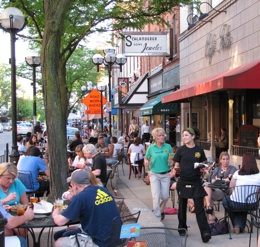Banks and offices are the buzz-kill of downtowns. Know why? Urban documentary filmmaker Kirk Westphal, founder of Westphal Associates, gives his view on this and other reasons why folks will do a hard stop and head no further down the block.
Post 1: Why Banks And Offices Are The Bane of Downtown
Posted By: Kirk Westphal
Posted: 3/2/2011
For these blog posts, I'm going to write about three major revelations I've had over the past few years. (At least those that relate to Concentrate's mission; if you want to chat about the paleolithic lifestyle or Toastmasters, well, let's have coffee. I'm in downtown Ann Arbor most days.)
This first post concerns downtowns. I really like a good downtown. By extension I really like good streets. And by "street" I mean all the stuff you can see as you're walking down one: the road; the sidewalk and all that's in it: people, cafe tables, merchandise displays, trees, benches, lampposts, sandwich boards; the buildings that enclose the street; and what you can see going on inside those buildings.
 It's a city's downtown streets, especially those two or three core streets that people would call the "main drag" at the center of a city (or a district within a city)that form the economic and spiritual heart of a community. It's where people shop and stroll, where parades are held, where protests or celebrations spontaneously happen, where historic buildings lend permanence and meaning to our geography.
It's a city's downtown streets, especially those two or three core streets that people would call the "main drag" at the center of a city (or a district within a city)that form the economic and spiritual heart of a community. It's where people shop and stroll, where parades are held, where protests or celebrations spontaneously happen, where historic buildings lend permanence and meaning to our geography.
Today, these streets are often spoken about in the context of attracting talent to an area. Young professionals (and many others) often state they want to live in or near a "real" downtown, and the language they use indicates that it's a place that's crowded, concentrated, and full of options within a short walk. The downtowns that pull this off are vibrant well into the evening, where it's possible to stroll and feel consistently safe and engaged throughout your visit.
I'll share a quick story with you. A couple of years ago, I was speaking with the manager of a business on South Main Street here in Ann Arbor. He was familiar with the documentary I had done for my masters degree. (It's called Insights into a Lively Downtown. it's a 19-minute video analysis of Ann Arborites' favorite streets, and you can watch it on YouTube here.) He said, "You'll appreciate this. The other night I was walking behind a student showing her parents around Main Street. They were heading north on Main to Washington Street, and when we got in front of Mongolian BBQ, she said, 'Main Street kind of ends here. Let's cross over.' And I wanted to say, 'Wait! My place is over there!'" He remarked that between the banks across the street and the "dark, empty offices" on the northwest corner of Main and Washington, he couldn't blame people for thinking that Main Street essentially ended at Washington Street.
See the excerpt below from my recent film, Great Street Toolkit, which talks about the importance of retail concentration and uses footage from Main & Washington as an example of how bank and office uses can hurt this goal.
So how many times can this happen in a downtown where people decide it's just not worth crossing to the next block before it's no longer interesting to walk anywhere? Granted, it's reassuring that we've got the great consecutive blocks that we do on Main Street (and State Street and South University), a fact that earned us a national award in 2009, but things can slowly change. What if a bank replaced the Parthenon restaurant? And what if offices moved into the ground floor of the Selo/Shevel Gallery?  There's no universal percentage for how many dull areas a downtown can withstand, but with each one you add, the more people will decide it's just not worth making a trip downtown. (For more about why banks are particularly insidious, see a recent report on my bank rant in the Ann Arbor Chronicle.)
There's no universal percentage for how many dull areas a downtown can withstand, but with each one you add, the more people will decide it's just not worth making a trip downtown. (For more about why banks are particularly insidious, see a recent report on my bank rant in the Ann Arbor Chronicle.)
A great piece of news is that the city is moving forward on implementing "design guidelines" for new buildings in the downtown. These will hopefully encourage a higher quality of architecture over the long term.
But let's not forget that pedestrians value buildings just as much, if not more, for what they offer on the inside. A couple of years ago, city council declined to follow the lead of some other cities and decided not to enact an ordinance that would have prevented the future displacement of retail by banks and offices (it's no secret I was a fan of the ordinance).
Perhaps this can be revisited. Because after all, don't we deserve downtown streets with both beauty and personality?I invite people to connect via Facebook or reach me at kirk@westphalassociates.com.